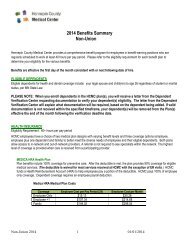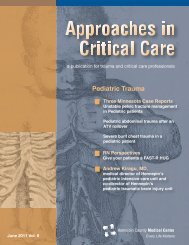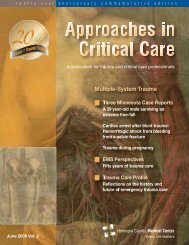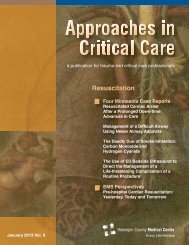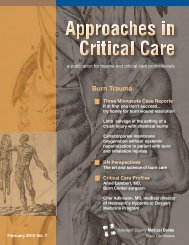Ischemic Stroke - Hennepin County Medical Center
Ischemic Stroke - Hennepin County Medical Center
Ischemic Stroke - Hennepin County Medical Center
You also want an ePaper? Increase the reach of your titles
YUMPU automatically turns print PDFs into web optimized ePapers that Google loves.
Case Reports<br />
and a Glasgow Coma Score (GCS) of 15.<br />
Secondary survey was remarkable only in his<br />
neurologic exam. He was alert and orientated<br />
to person, place and time. He had a left facial<br />
droop and dysarthria. There was no gaze preference.<br />
Strength was 5/5 RUE and RLE, and<br />
0/5 LUE and LLE. Response to light touch and<br />
pinprick were mostly absent on left side.<br />
Scoring on the National Institutes of Health<br />
(NIH) stroke scale was 13 on presentation.<br />
Chest x-ray and electrocardiogram (ECG)<br />
obtained in the Emergency Department were<br />
normal. The patient was packaged for head<br />
CT with the acute stroke team present.<br />
Given the long time period between being last<br />
seen normal and presentation (>12 hours), the<br />
patient was initially not considered a candidate<br />
for intravenous (IV) thrombolytics. He was<br />
taken for a non-contrast head CT scan to rule<br />
out hemorrhage. This was negative for an acute<br />
bleed. He then underwent emergent magnetic<br />
resonance imaging (MRI) and magnetic resonance<br />
angiography (MRA) to evaluate the<br />
extent of the injury. His brain MRI demonstrated<br />
an acute infarction of the middle cerebral<br />
artery distribution involving the right insular<br />
cortex and posterior limb of the right internal<br />
capsule and right corona radiata, along with<br />
chronic small vessel ischemic disease. The<br />
MRA demonstrated occlusion of the right middle<br />
cerebral artery beyond the proximal M1 segment,<br />
without distal reconstitution. The neck<br />
MRA demonstrated 40% stenosis of proximal<br />
right internal carotid artery. He was felt to be<br />
beyond the time window of intervention and<br />
taken to the ICU for further management.<br />
After arriving in the ICU, he developed a new<br />
right gaze preference and hemi-neglect. It was<br />
felt that these likely represented signs of ongoing<br />
ischemia/infarction and he was emergently<br />
taken for a CT perfusion study, which revealed<br />
diminished perfusion over the entire right middle<br />
cerebral artery (MCA) territory consistent with<br />
ischemia and a small localized area of infarction<br />
in the right insula similar to the infarct<br />
seen on MRI. (See Figure One on page 8.)<br />
Given these findings, he was felt to have a<br />
large area of ischemic but not-yet-infarcted<br />
brain (termed “penumbra.”) He was emergently<br />
taken to angiography, where he received lowdose<br />
intra-arterial tPA and angioplasty of the<br />
M1 lesion. This resulted in TIMI 3 flow and he<br />
was noted to have antigravity strength on the<br />
left side and improvement in his dysarthia.<br />
On hospital day (HD) 2, the patient was ambulating<br />
with assistance and had 4/5 strength<br />
proximal and distal in the LUE and LLE. A<br />
thromboembolic work-up including a transesophageal<br />
ECG was negative and it was felt<br />
that his stroke was a result of atherosclerotic<br />
vascular disease. Risk factors identified were<br />
his gender and hypertension. His LDL was 84<br />
and he was considered a candidate for statin<br />
therapy. On HD 3, his NIH stroke scale score<br />
was 3 with residual difficulties with speech and<br />
word finding. He underwent aggressive PT/OT<br />
and was discharged home on HD 6.<br />
On follow-up, the patient has persistent mild<br />
weakness in the left arm and leg along with<br />
some coordination difficulty. He is otherwise<br />
at baseline except for his memory and<br />
activity tolerance.<br />
Discussion<br />
This case illustrates that intervention is not limited<br />
solely to three hours after symptom onset,<br />
which is the current standard for IV tPA.<br />
Studies published in late 2008 may alter this<br />
standard. Because the clock starts when the<br />
patient was last seen normal, which includes<br />
cases where the patient wakes up or is found<br />
symptomatic, this patient was considered to be<br />
symptomatic for nearly 12 hours. The patient<br />
had some area of brain that was ischemic for<br />
nearly 12 hours but the patient also had a<br />
much larger area of ischemic brain for less<br />
than 3 hours when he clinically deteriorated in<br />
the hospital.<br />
The patient was initially not considered a candidate<br />
for acute stroke intervention because he<br />
Approaches in Critical Care | December 2008 | 7





